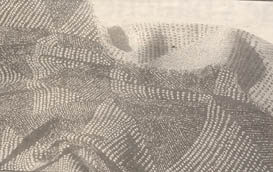Elegant fabrications
The son of a traditional weaver and grandson of a spinner, Arai was born in 1932 in Kiryu, a town north of Tokyo known for its tradition of kimono-making. In 1950, in his father's factory, he began weaving obi and kimono fabric, as well as cloth made of gold and silver fibers for Western clothes. Dissatisfied with the strictures of the business, he struck out on his own,
developing new techniques for making and weaving metallic yarns. Traveling to Mexico, India and Southeast Asia in 1968, he taught these metallic yarn techniques to others while also studying the techniques and materials used by native weavers.
Finding that Latin American cloth often contains mixtures of materials such as cotton and wool, he began including a variety of elements, including polyester, nylon and metallic and film-like materials in his work. In 1979, with the help of a computer, he pioneered new ways of programming Jacquard looms, which are driven by punch cards, to produce richly complicated
patterns unimaginable in the past. Using materials that reacted differently to extreme heat, such as cotton and wool, he created fabrics with distortions that had a sculptural effect, and in the 1980s made many of the textiles used by fashion designer Issey Miyaki.
At b. sakata garo, 923 20th St., through April 4, 3 to 6 p.m. Tuesdays -- Fridays, and noon to 6 p.m. Saturdays; (916) 447-4276.
The show at b. sakata garo offers a look at a wide range of his creations, from playful woolen weavings that mimic the waving tendrils of sea anemones and whimsical puffs of smoke to a weblike, bronze metallic weaving that is draped around the gallery's dramatic spiral staircase. It also includes woven shawls as fine as Spanish moss, soft and supple stainless steel handbags.
The jackets use innovative woven cloths that when cut produce effects ranging from matted tendrils that resemble dreadlocks to flaps, pockets and scallops that give the garments sculptural qualities. There is even a hooded jacket made of bulletproof cloth for celebrities plagued by stalkers.
Some of the most elegant pieces in the exhibition are seemingly simple, though in reality extremely complex. For "Shivalingam," a four-sided Jacquard weaving with subtle, undulating patterns, Arai screened photographs of sand patterns to create a complex abstract "painting" in cloth.
This was mentioned on the phone during a conversation with Yoshiko Wada, who is serving as Arai's translator and is a visiting scholar at the Center for Japanese Studies at the University of California, Berkeley.
For "African Shibori," Arai used a complicated method of tie-dying to create intricate patterns of stripes and spiral sunbursts. For "Crackled Ice," he ran crinkled polyester through high heat to produce a highly reflective, faceted surface that shimmers like, well, crackled ice.
The piece de resistance of the show, "Spirit Tree," says Wada, was a collaboration between Arai and his wife, noted Japanese printmaker Riko Arai, that uses natural sheep's fleece from Australia woven on a computerized Jacquard loom. The sepia-toned image of a tree is produced with intricate, subtlely shaded tones that give the tapestry a depth and complexity unusual in
contemporary textiles.
|
|||||||||||||||||||||
